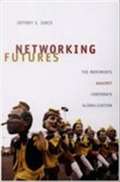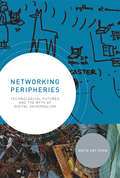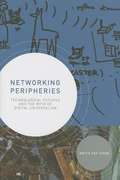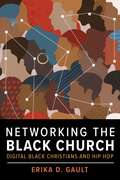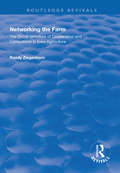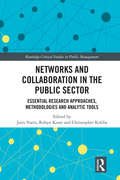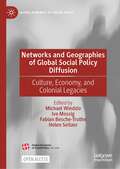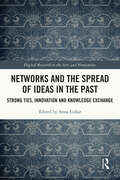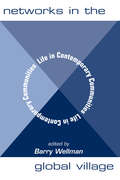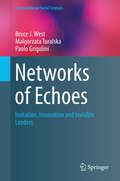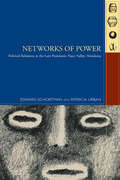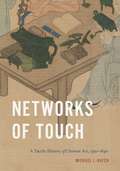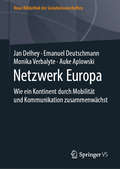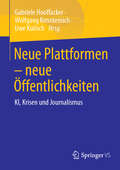- Table View
- List View
Networking and Community Partnership: Second Edition (Routledge Revivals)
by Steve TrevillionFirst published in 1999, this volume is a revised and fully updated version of the ground breaking book Caring in the Community which was the first book to attempt to develop a theory of networking for social workers and others. It is still the only book which has systematically applied key networking principles to both community care and child care. There is now no doubt that the time has come for a new edition which will take into account the developments which have taken place in social care since the work was first published. This edition will also incorporate comparative European material thereby placing networking principles in a broader context.
Networking Futures: The Movements Against Corporate Globalization
by Jeffrey S. JurisSince the first worldwide protests inspired by Peoples' Global Action (PGA)--including the mobilization against the November 1999 World Trade Organization meetings in Seattle--anti-corporate globalization activists have staged direct action protests against multilateral institutions in cities such as Prague, Barcelona, Genoa, and Cancun. Barcelona is a critical node, as Catalan activists have played key roles in the more radical PGA network and the broader World Social Forum process. In 2001 and 2002, the anthropologist Jeffrey S. Juris participated in the Barcelona-based Movement for Global Resistance, one of the most influential anti-corporate globalization networks in Europe. Combining ethnographic research and activist political engagement, Juris took part in hundreds of meetings, gatherings, protests, and online discussions. Those experiences form the basis of Networking Futures, an innovative ethnography of transnational activist networking within the movements against corporate globalization. In an account full of activist voices and on-the-ground detail, Juris provides a history of anti-corporate globalization movements, an examination of their connections to local dynamics in Barcelona, and an analysis of movement-related politics, organizational forms, and decision-making. Depicting spectacular direct action protests in Barcelona and other cities, he describes how far-flung activist networks are embodied and how networking politics are performed. He further explores how activists have used e-mail lists, Web pages, and free software to organize actions, share information, coordinate at a distance, and stage "electronic civil disobedience. " Based on a powerful cultural logic, anti-corporate globalization networks have become models of and for emerging forms of radical, directly democratic politics. Activists are not only responding to growing poverty, inequality, and environmental devastation; they are also building social laboratories for the production of alternative values, discourses, and practices.
Networking in Japanese Factory Automation (Routledge Library Editions: Japan)
by Koichi Kishimoto Hiroshi Tanaka Yoshio Sashida Yasuhisa ShiobaraIn Japan information technology has been a vital part of manufacturing for decades. A central factory computer provides a production plan and shop minicomputers and microcomputers in the factory run machines that manufacture products. It has become necessary to connect computers installed at different locations to enable information exchange between different sections. This requires an intracompany network with large memory capacity and high-speed communication capability to process documents, drawings, and image data, as well as conventional code data: a local area network (LAN). This volume discusses the ring-type LAN; the TOSLINE-8000 high-speed optical data highway for high-speed real-time control systems; the TOSLINE-2000E, a compact, low-cost independent local area network; the status of MAP, a communications protocol for manufacturing automation established by General Motors and MAP activities in Japan
Networking Peripheries: Technological Futures and the Myth of Digital Universalism (The\mit Press Ser.)
by Anita Say ChanAn exploration of the diverse experiments in digital futures as they advance far from the celebrated centers of technological innovation and entrepreneurship.In Networking Peripheries, Anita Chan shows how digital cultures flourish beyond Silicon Valley and other celebrated centers of technological innovation and entrepreneurship. The evolving digital cultures in the Global South vividly demonstrate that there are more ways than one to imagine what digital practice and global connection could look like. To explore these alternative developments, Chan investigates the diverse initiatives being undertaken to “network” the nation in contemporary Peru, from attempts to promote the intellectual property of indigenous artisans to the national distribution of digital education technologies to open technology activism in rural and urban zones.Drawing on ethnographic accounts from government planners, regional free-software advocates, traditional artisans, rural educators, and others, Chan demonstrates how such developments unsettle dominant conceptions of information classes and innovations zones. Government efforts to turn rural artisans into a new creative class progress alongside technology activists' efforts to promote indigenous rights through information tactics; plans pressing for the state wide adoption of open source–based technologies advance while the One Laptop Per Child initiative aims to network rural classrooms by distributing laptops. As these cases show, the digital cultures and network politics emerging on the periphery do more than replicate the technological future imagined as universal from the center.
Networking Peripheries
by Anita Say ChanIn "Networking Peripheries," Anita Chan shows how digital cultures flourish beyond Silicon Valley and other celebrated centers of technological innovation and entrepreneurship. The evolving digital cultures in the Global South vividly demonstrate that there are more ways than one to imagine what digital practice and global connection could look like. To explore these alternative developments, Chan investigates the diverse initiatives being undertaken to "network" the nation in contemporary Peru, from attempts to promote the intellectual property of indigenous artisans to the national distribution of digital education technologies to open technology activism in rural and urban zones. Drawing on ethnographic accounts from government planners, regional free-software advocates, traditional artisans, rural educators, and others, Chan demonstrates how such developments unsettle dominant conceptions of information classes and innovations zones. Government efforts to turn rural artisans into a new creative class progress alongside technology activists efforts to promote indigenous rights through information tactics; plans pressing for the state wide adoption of open source--based technologies advance while the One Laptop Per Child initiative aims to network rural classrooms by distributing laptops. As these cases show, the digital cultures and network politics emerging on the periphery do more than replicate the technological future imagined as universal from the center.
Networking the Black Church: Digital Black Christians and Hip Hop (Religion and Social Transformation #13)
by Erika D. GaultProvides a timely portrait of young Black Christians and how digital technology is transforming the Black ChurchThey stand at the forefront of the Black Lives Matter movement, push the boundaries of the Black Church through online expression of Christian hip hop, and redefine what it means to be young, Black, and Christian in America. Young Black adults represent the future of African American religiosity, yet little is known regarding their religious lives beyond the Black Church. Networking the Black Church explores how deeply embedded digital technology is in the lives of young Black Christians, offering a first-of-its-kind digital-hip hop ethnography. Erika D. Gault argues that a new religious ethos has emerged among young adult Blacks in America. To understand Black Christianity today it is not enough to look at the traditional Black Church. The Black Church is itself being changed by what she calls digital Black Christians. The volume examines the ways in which Christian hip hop artists who have adopted Black-preaching-inspired spoken word performances create alternate kinds of Christian communities both inside and outside the walls of traditional Black churches. Framed around interviews with prominent Black Christian hip hop artists, it explores the multiple ways that digital Black Christians construct religious identity and meaning through video-sharing and social media. In the process, these digital Black Christians are changing Black churches as institutions, transforming modes of religious activism, inventing new communication practices around evangelism and Christian identity, and streamlining the accessibility of Black Church cultural practices in popular culture. Erika D. Gault provides a fascinating portrait of young Black faith, illuminating how the relationship between religion and digital media is changing the lived experiences of a new generation of Black Christians.
Networking the Farm: The Social Structure of Cooperation and Competition in Iowa Agriculture (Routledge Revivals)
by Randy ZiegenhornPublished in 1999, this book presents the results of an ethnographic study of the emergence of co-operative production networks among hog farm workers in Iowa. In it the author assesses both the internal organizational requirements for the successful network formation and the potential for networks to give farmers a competitive edge in the swine industry. Departing from the traditional emphasis on individual decision making in agricultural economies and economic anthropology, this book emphasizes instead the institutional setting in which such networks are formed. The author argues that networks succeed when they are closely tied to and reflective of local social structure. Those networks that attempt to employ a master plan designed by experts often fail. Although many succesful networks exist, networking has yet to achieve the economic clout enjoyed by large scale corporate swine producers. The author describes the availability of credit for new swine production ventures in Iowa and shows the extent to which large scale producers have developed network-like connections with banks, packers, and contract producers.
Networks and Collaboration in the Public Sector: Essential research approaches, methodologies and analytic tools (Routledge Critical Studies in Public Management)
by Joris Voets Robyn Keast Christopher KolibaNetworks and other collaborations are central to the public sector’s ability to respond to their diverse responsibilities, from international development and regional governance, to policy development and service provision. Great strides have been made toward understanding their formation, governance and management, but more opportunities to explore methodologies and measures is required to ensure they are properly understood. This volume showcases an array of selected research methods and analytics tools currently used by scholars and practitioners in network and collaboration research, as well as emerging styles of empirical investigation. Although it cannot attempt to capture all technical details for each one, this book provides a unique catalogue of compelling methods for researchers and practitioners, which are illustrated extensively with applications in the public and non-profit sector. By bringing together leading and upcoming scholars in network research, the book will be of enormous assistance in guiding students and scholars in public management to study collaboration and networks empirically by demonstrating the core research approaches and tools for investigating and evaluating these crucially important arrangements.
Networks and Geographies of Global Social Policy Diffusion: Culture, Economy, and Colonial Legacies (Global Dynamics of Social Policy)
by Michael Windzio Ivo Mossig Fabian Besche-Truthe Helen SeitzerThis open access book analyses the global diffusion of social policy as a process driven by multiplex ties between countries in global social networks. The contributions analyze links between countries via global trade, colonial history, similarity in culture, and spatial proximity. Networks are viewed as the structural backbone of the diffusion process, and diffusion is anlaysed via several subfields of social policy, in order to interrogate which network dimensions drive this process. The focus is on a global perspective of social policy diffusion via networks, and it is the first book to explicitly follow this macro-quantitative perspective on diffusion at a global scale whilst also comparing different networks. The collection tests the network structures in terms of their relevance to the diffusion process in different subfields of social policy such as old age and survivor pensions, labor and labor markets, health and long-term care, education and training, and family and gender policy.The book will therefore be invaluable to students and researchers of global social policy, sociology, political science, international relations, organization theory and economics.
Networks and the Spread of Ideas in the Past: Strong Ties, Innovation and Knowledge Exchange (Digital Research in the Arts and Humanities)
by Anna CollarNetworks and the Spread of Ideas in the Past: Strong Ties, Innovation and Knowledge Exchange gathers contributions from an international group of scholars to reconsider the role that strong social ties play in the transmission of new ideas, and their crucial place in network analyses of the past. Drawing on case studies that range from the early Iron Age Mediterranean to medieval Britain, the contributing authors showcase the importance of looking at strong social ties in the transmission of complex information, which requires relationships structured through mutual trust, memory, and reciprocity. They highlight the importance of sanctuaries in the process of information transmission; the power of narrative in creating a sense of community even across geographical space; and the control of social systems in order to facilitate or stifle new information transfer. Networks and the Spread of Ideas in the Past demonstrates the value of searching the past for powerful social connections, offers us the chance to tell more human stories through our analyses, and represents an essential new addition to the study and use of networks in archaeology and history. The book will be useful to academics and students working in the Digital Humanities, History, Archaeology.
Networks, Crowds, and Markets
by David Easley Jon KleinbergAre all film stars linked to Kevin Bacon? Why do the stock markets rise and fall sharply on the strength of a vague rumour? How does gossip spread so quickly? Are we all related through six degrees of separation? There is a growing awareness of the complex networks that pervade modern society. We see them in the rapid growth of the Internet, the ease of global communication, the swift spread of news and information, and in the way epidemics and financial crises develop with startling speed and intensity. This introductory book on the new science of networks takes an interdisciplinary approach, using economics, sociology, computing, information science and applied mathematics to address fundamental questions about the links that connect us, and the ways that our decisions can have consequences for others.
Networks for Water Policy: A Comparative Perspective (Routledge Library Editions: Water Resources)
by Hans Bressers Laurence J. O’Toole Jr Jeremy RichardsonNetwork models for analysing public policy have become widely used in recent years. This volume, originally published in 1995, assesses the network idea by applying a common perspective on network analysis to the constellations involved in water policy formation and implementation in England and Wales, Germany, Hungary, the Netherlands, the USA and at the level of the EU. Water policy – addressing basic human needs for the supply of adequate surface and groundwater as well as for the maintenance and improvement of water quality, is an increasingly salient subject. Each case covered in this volume treats the issues of water policy network composition and structure, and determinants of network characteristics, as well as documenting the influence of the networks on policy developments towards more network openness, emulation of business behaviour nd less domination by traditional professional groups such as engineers. Essays by the editors provide a common analytical perspective and offer both explicitly-comparative conclusions and evidence-based assessments of the strengths and limitations of the network perspective.
Networks in Social Policy Problems
by Vedres Balázs Marco ScottiNetwork science is the key to managing social communities, designing the structure of efficient organizations and planning for sustainable development. This book applies network science to contemporary social policy problems. In the first part, tools of diffusion and team design are deployed to challenges in adoption of ideas and the management of creativity. Ideas, unlike information, are generated and adopted in networks of personal ties. Chapters in the second part tackle problems of power and malfeasance in political and business organizations, where mechanisms in accessing and controlling informal networks often outweigh formal processes. The third part uses ideas from biology and physics to understand global economic and financial crises, ecological depletion and challenges to energy security. Ideal for researchers and policy makers involved in social network analysis, business strategy and economic policy, it deals with issues ranging from what makes public advisories effective to how networks influence excessive executive compensation.
Networks in the Global Village: Life in Contemporary Communities
by Barry Wellman<p>Networks in the Global Village examines how people live through personal communities: their networks of friends, neighbors, relatives, and coworkers. It is the first book to compare the communities of people around the world. Major social differences between and within the First, Second, and Third Worlds affect the opportunities and insecurities with which individuals and households must deal, the supportive resources they seek, and the ways in which markets, institutions, and networks structure access to these resources. Each article written by a resident shows how living in a country affects the ways in which people use networks to access resources. <p>Most people's ties in the developed world are not with neighbors but are widely dispersed. Unlike traditional studies of communities, social network analysis can identify the flourishing personal communities that people do have, no matter how far their ties may stretch and how fragmented their communities may be.Social networks are one of the principal means by which people and households acquire resources—either directly, through informal exchanges, or indirectly, by providing information on how to access the services provided by governments and other institutions. Networks in the Global Village focuses on how people use these networks around the world.
Networks, Knowledge Brokers, and the Public Policymaking Process
by Matthew S. Weber Itzhak YanovitzkySocial network analysis provides a meaningful lens for advancing a more nuanced understanding of the communication networks and practices that bring together policy advocates and practitioners in their day-to-day efforts to broker evidence into policymaking processes. This book advances knowledge brokerage scholarship and methodology as applied to policymaking contexts, focusing on the ways in which knowledge and research are utilized, and go on to influence policy and practice decisions across domains, including communication, health and education. There is a growing recognition that knowledge brokers – key intermediaries – have an important role in calling attention to research evidence that can facilitate the successful implementation of evidence-informed policies and practices. The chapters in this volume focus explicitly on the history of knowledge brokerage research in these contexts and the frameworks and methodologies that bridge these disparate domains. The contributors to this volume offer useful typologies of knowledge brokerage and explicate the range of causal mechanisms that enable knowledge brokers’ influence on policymaking. The work included in this volume responds to this emerging interest by comparing, assessing, and delineating social network approaches to knowledge brokerage across domains. The book is a useful resource for students and scholars of social network analysis and policymaking, including in health, communication, public policy and education policy.
Networks Of Dissolution: Somalia Undone
by Anna SimonsIn this penetrating and timely book, Anna Simons documents Somalia's impending slide toward anarchy. How do people react to a failing yet still repressive government? What do they do when the banks run out of cash? How do they cope with unprecedented uncertainty? These are some of the questions Simons addresses as she introduces the reader to Somal
Networks of Echoes
by Bruce J. West Malgorzata Turalska Paolo GrigoliniNetworks of Echoes: Imitation, Innovation and Invisible Leaders is a mathematically rigorous and data rich book on a fascinating area of the science and engineering of social webs. There are hundreds of complex network phenomena whose statistical properties are described by inverse power laws. The phenomena of interest are not arcane events that we encounter only fleetingly, but are events that dominate our lives. We examine how this intermittent statistical behavior intertwines itself with what appears to be the organized activity of social groups. The book is structured as answers to a sequence of questions such as: How are decisions reached in elections and boardrooms? How is the stability of a society undermined by zealots and committed minorities and how is that stability re-established? Can we learn to answer such questions about human behavior by studying the way flocks of birds retain their formation when eluding a predator? These questions and others are answered using a generic model of a complex dynamic network--one whose global behavior is determined by a symmetric interaction among individuals based on social imitation. The complexity of the network is manifest in time series resulting from self-organized critical dynamics that have divergent first and second moments, are non-stationary, non-ergodic and non-Poisson. How phase transitions in the network dynamics influence such activity as decision making is a fascinating story and provides a context for introducing many of the mathematical ideas necessary for understanding complex networks in general. The decision making model (DMM) is selected to emphasize that there are features of complex webs that supersede specific mechanisms and need to be understood from a general perspective. This insightful overview of recent tools and their uses may serve as an introduction and curriculum guide in related courses.
Networks of Power: Political Relations in the Late Postclassic Naco Valley (Mesoamerican Worlds : From The Olmecs To The Danzantes Ser.)
by Edward Schortman Patricia Urban Patricia A UrbanLittle is known about how Late Postclassic populations in southeast Mesoamerica organized their political relations. Networks of Power fills gaps in the knowledge of this little-studied area, reconstructing the course of political history in the Naco Valley from the fourteenth through early sixteenth centuries. Describing the material and behavioral patterns pertaining to the Late Postclassic period using components of three settlements in the Naco Valley of northwestern Honduras, the book focuses on how contests for power shaped political structures. Power-seeking individuals, including but not restricted to ruling elites, depended on networks of allies to support their political objectives. Ongoing and partially successful competitions waged within networks led to the incorporation of exotic ideas and imported items into the daily practices of all Naco Valley occupants. The result was a fragile hierarchical structure forever vulnerable to the initiatives of agents operating on local and distant stages. Networks of Power describes who was involved in these competitions and in which networks they participated; what resources were mustered within these webs; which projects were fueled by these assets; and how, and to what extent, they contributed to the achievement of political aims.
Networks of Touch: A Tactile History of Chinese Art, 1790–1840 (Perspectives on Sensory History)
by Michael J. HatchIn early nineteenth-century China, a remarkable transformation took place in the art world: artists among China’s educated elites began to use touch to forge a more authentic relationship to the past, to challenge stagnant artistic canons, and to foster deeper human connections. Networks of Touch is an engaging exploration of this sensory turn.In this book, Michael J. Hatch examines the artistic network of Ruan Yuan (1764–1849), a scholar-official whose patronage supported a generation of artists and learned people who prioritized epigraphic research as a means of truing the warped contours of Confucian heritage. Their work instigated an “epigraphic aesthetic”—an appropriation of the stylistic, material, and tactile features of ancient inscribed objects and their reproductive technologies—in late eighteenth- and early nineteenth-century artwork. Rubbings, a reduplicative technology, challenged the dominance of brushwork as the bearer of artistic authority. While brushwork represented the artist’s physical presence through ink and paper, rubbings were direct facsimiles of tactile experiences with objects. This shift empowered artists and scholars to transcend traditional conventions and explore new mediums, uniting previously separate image-making practices while engaging audiences through the senses.Centering on touch and presenting a fresh perspective on early nineteenth-century literati art in China, this volume sheds light on a period often dismissed as lacking innovation and calls into question optical realism’s perceived supremacy in reshaping the sensory experience of the modern Chinese viewer.
Netzwerk Europa: Wie ein Kontinent durch Mobilität und Kommunikation zusammenwächst (Neue Bibliothek der Sozialwissenschaften)
by Jan Delhey Emanuel Deutschmann Monika Verbalyte Auke AplowskiDas Buch zeigt auf, wie sehr Europa in den letzten Jahrzehnten auf dem Weg zu einer immer engeren Union der Bürgerinnen und Bürger vorangekommen ist. Fast unbemerkt von Öffentlichkeit und Wissenschaft hat sich Europa „von unten“, durch grenzüberschreitende Aktivitäten der Menschen, sozial integriert. Mit anderen Worten: Es gibt unzählige Prozesse der europäischen Vergesellschaftung, die sich zum Netzwerk Europa verdichtet haben – keine supranationale Gesellschaft im klassischen Sinne, sondern ein Verdichtungsraum personeller Mobilität und Kommunikation. Das Buch widmet sich dieser europäischen Vergesellschaftung anhand von Migration, Auslandsstudium, Tourismus und Telefonie – und diskutiert, welche Chancen und Konflikte sich daraus für das Zusammenleben der Europäerinnen und Europäer ergeben.
Netzwerk- und Sozialraumarbeit im Kontext von Migration, Flucht und Integration
by Süleyman GögercinDas Buch zeigt, wo Theorie und Praxis einer netzwerk- und sozialraumorientierten Sozialen Arbeit im Kontext von Migration, Flucht und Integration stehen und wie und wohin sie miteinander verzahnt weiterentwickelt werden könnten. Anliegen des Buches ist es, die in Theorie und Praxis gemachten Erfahrungen und gesammelten Erkenntnisse zu bündeln, das aktuell verfügbare Konzept- und Handlungswissen für Netzwerk- und Sozialraumarbeit zu erschließen und zu erweitern, den erreichten Diskussionsstand aufzuzeigen sowie Anstöße für weiterführende Diskussionen und Weiterentwicklung der Sozialen Arbeit zu liefern.
Neue Gewerkschaftskonkurrenz im Bahnwesen
by Viktoria KalassViktoria Kalass beschreibt die Veränderungen um die Gewerkschaft Deutscher Lokomotivführer (GDL), die sich seit der Jahrtausendwende sukzessive zu einem autarken Tarifakteur mit eigenständigen gewerkschaftspolitischen Zielsetzungen und Forderungen gewandelt hat. Nach einem gescheiterten Anlauf im Rahmen der Tarifrunde 2002/2003, gelang es der Lokführergewerkschaft 2007/2008 schließlich, mittels eines langwierigen Arbeitskampfes einen Spartentarif und eine Einkommenserhöhung von rund 11 % durchzusetzen. Die Autorin analysiert die Ursachen, Bedingungen und Konsequenzen des Lokführerstreiks für die Arbeitsbeziehungen des Bahnwesens, aber auch die Motive der GDL, eigenständige Tarifansprüche anzumelden.
Neue Landschaftsgeographie: Ein Überblick (essentials)
by Olaf Kühne Corinna Jenal Florian WeberIn diesem essential werden Meilensteine des Perspektivwechsels hin zu einer ,neuen Landschaftsgeographie‘ beleuchtet. ,Landschaft‘ gehört zu einem alltagsweltlich verankerten und vielgenutzten Begriff und Konzept. Nachdem die Landschaftsgeographie in der ersten Hälfte des 20. Jahrhunderts den ,Kern‘ des Faches bildete, geriet sie in den 1960er Jahren im Zuge einer Ausrichtung auf quantitative ,Raum‘-Forschungsansätze in den Hintergrund und sogar in Verruf. Seit den 2000er Jahren wird sich ,Landschaft‘ aus konstruktivistischen Perspektiven heraus erneut mit anderer Ausrichtung angenähert: Nicht mehr die Suche nach der ,Essenz‘ von ,Landschaft‘ steht im Fokus, sondern die Frage, wie diese sozial konstruiert wird. Zentrale aktuelle Ausrichtungen werden mit Forschungsbeispielen verdeutlicht, um einen Einblick in die ,neue Landschaftsgeographie‘ zu geben.
Neue osteuropäische Migration nach Australien: Von Tschechien, Ungarn und der Ukraine bis nach Sydney und darüber hinaus
by Olga OleinikovaDieses Buch identifiziert und untersucht neue Formen und Wege der osteuropäischen Migration nach Australien seit den 2000er Jahren und bietet aktualisierte Trends zeitgenössischer Migrationsbewegungen von Ukrainern, Ungarn und Tschechen nach Australien. Mit Kapiteln, die die Vielfalt und Komplexität dieser neuen beschleunigten Wellen osteuropäischer Migration in den asiatisch-pazifischen Raum hervorheben, bietet dieses Buch neue Einblicke, die unser Verständnis der osteuropäischen Mobilität im 21. Jahrhundert bereichern. Das Buch richtet sich an Studierende, Wissenschaftler und politische Entscheidungsträger in den Bereichen Migration, Soziologie, Politikwissenschaft und internationale Beziehungen.
Neue Plattformen – neue Öffentlichkeiten: KI, Krisen und Journalismus
by Gabriele Hooffacker Wolfgang Kenntemich Uwe KulischAlgorithmen und Künstliche Intelligenz wie die generative Sprach-KI ChatGPT übernehmen journalistische und publizistische Aufgaben – bei der Recherche, bei Produktion und Distribution. Wie ist es um die Zukunft des Journalismus unter den rasant sich verändernden Rahmenbedingungen bestellt? Worauf müssen sich Medienschaffende und Rezipienten einstellen? Wie können Medien auch in Krisenzeiten möglichst unabhängig bleiben und weiterhin Voraussetzung für eine funktionierende Demokratie sein? Der Band versammelt Beiträge zur Fachtagung "Neue Plattformen – neue Öffentlichkeiten" im September 2023 an der HTWK Leipzig.

